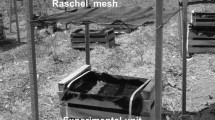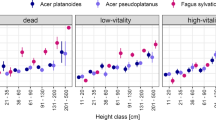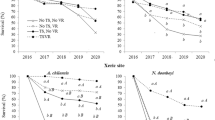Summary
Seedlings of six species of rainforest trees with widely constrasting ecology and seed morphology were transplanted at 3 weeks of age into tree-fall gaps and the shaded understoreys at two rainforest sites (Curtain Fig and Lamins Hill) on the Atherton Tableland, North Queensland, Australia. In each forest habitat, half of the transplanted seedlings were protected from vertebrates by means of wire cages, and survival was monitored over 16 months. The main objective was to estimate the extent to which independent variables (forest, habitat, protection from vertebrates, and species) contribute to explaining survival differences among the seedlings. Significant differences existed in the mortality among species, whether caged or uncaged. Seedlings unprotected from vertebrates suffered greater mortality (i.e. averaged over all species and forests, mortality > 75%), compared to the caged seedlings (mortality < 40%). Seedling of most species survived better in forest gaps, though the effects varied significantly among the six species. Survival of caged seedlings in Curtain Fig was significantly greater than in Lamins Hill, a pattern attributed to the partial deciduousness of the Curtain Fig forest. Because only few of the uncaged seedlings survived to 16 months, we focussed on the caged seedlings to examine the role of light at the forest habitats on survival. Relationship between seedling mortality and increasing light availability vary significantly among the six species. However across species, seedling mortality decreased linearly as photosynthetically active radiation (PAR) rose from 0.48 to 2.0%, after which an asymptote was reached and further increase in light (up to 8% PAR) did not influence survival significantly. Overall, temporal, species and the various environmental variables and their interactions explained about 60% of the variations in the seedling mortality data, with protection and species differences making the greatest contributions.
Similar content being viewed by others
References
Augspurger CK (1984a) Light requirements of neotropical tree seedlings: a comparative studies of survival and growth. J Ecol 72:777–795
Augspurger CK (1984b) Seedling survival of tropical tree species: interactions of dispersal distance, light gaps and pathogens. Ecology 65:1705–1712
Bazzaz FA, Pickett STA (1980) Physiological ecology of tropical succession: a comparative review. Annu Rev Ecol Syst 11:287–310
Bell FC, Winter JW, Pahl LI, Atherton RG (1987) Distribution, area and tenure of rainforest in Northeastern Australia. Proc R Soc Queens 98:27–39
Cook RE (1979) Patterns of juvenile mortality and recruitment in plants. In: Solbrig OT, Jain S, Johnson GB, Raven PH (eds). Topics in plant population biology. Columbia University, Press, New York, pp 207–231
Cox DR (1972) Regression models and life tables. J R Statist Soc 34:187–220
Denslow JS (1987) Tropical rainforest gaps and tree diversity. Annu Rev Ecol Syst 18:431–451
Foster SA (1986) On the adaptive values of large seeds for tropical moist forest trees: a review and synthesis. Bot Rev 5:260–299
Francis WD (1981) Australian rainforest trees. Australian Publishing Service. Canberra, Australia
Fried JS, Tappeiner JC, Hibbs DE (1988) Bigleaf maple seedling establishment and early growth in Douglas-fir forests. Can J For Res 18:1226–1233
Hartshorn GS (1978) Treefalls and tropical forest dynamics. In: Tomlinson PB, Zimmermann MH (eds). Tropical trees as living systems. Cambridge University Press, London, pp 617–638
Hopkins MS, Graham AW (1983) The species composition of viable seed banks beneath lowland tropical rainforests in North Queensland, Australia. Biotropica 15:90–99
Hopkins MS, Tracey JG, Graham AW (1990) The size and composition of soil seed-banks in remnant patches of three structural rainforest types in North Queensland. Aust J Ecol 15:43–50
Howe HF (1990) Survival and growth of juvenile ofVirola surinamensis in Panama: Effects of herbivory and canopy closure. J Trop Ecol 6:259–280
Howe HF, Westley LC (1988) Ecological relationships of plants and animals. Oxford University Press, Oxford
Howe HF, Schupp EW, Westley LC (1985) Early consequences of seed dispersal for a neotropical tree (Virola surinamensis). Ecology 66:781–791
Hyland BPM (1982) A revised card key to rainforest trees of North Queensland. CSIRO, Melbourne
Isbell RF, Stephenson PJ, Murtha GG, Gilman GP (1976) Red basaltic soil in north Queensland. C.S.I.R.O. Australia. Division of Soils Technical Paper No 28
Janzen DH (1971) Escape of juvenileDioclea megacarpa (Leguminosae) vines from predators in a deciduous tropical forest. Am Nat 105:97–112
Kitajima K, Augspurger CK (1989) Seed and seedling ecology of a monocarpic tropical tree,Tachigalia versicolor. Ecology 70:1102–1114
Lane P, Galwey N, Alvey N (1987) Genstat 5, An introduction. Clarendon Press, London
Lawton RO, Putz FE (1988) Natural disturbance and gap-phase regeneration in a wind-exposed tropical cloud forest. Ecology 69:764–777
McCullagh P, Nelder JA (1989) Generalized Linear models. Chapman and Hall, London
Myster RW, McCarthy BC (1989) Effects of herbivory and competition on survival and growth ofCarya tomentosa (Juglandaceae) seedlings. Oikos 56:145–148
Schupp EW (1988) Seed and early seedling predation in the forest understorey and in treefall gaps. Oikos 51:71–78
Schupp EW (1990) Annual variation in seedfall, postdispersal predation and recruitment of a neotropical tree. Ecology 71:504–515
Schupp EW, Howe HF, Augspurger CK, Levey DJ (1989) Arrival and survival in tropical treefall gaps. Ecology 70:562–564
Sork VL (1983) Mammalian seed dispersal of pignut hickory during three fruiting seasons. Ecology 64:1049–1056
Sork VL (1987) Effects of predation and light on seedling establishment inGustava superba. Ecology 68:1341–1350
Tracey JG (1982) The vegetation of the humid tropical region of North Queensland. CSIRO Melbourne
Turner IM (1990) Tree seedling growth and survival in a Malaysian forest. Biotropica 22:146–154
Webb SL, Willson MF (1985) Spatial heterogeneity in post-dispersal predation onPrunus andUvularia seeds. Oecologia. 67:150–153
Whelan CJ, Willson MF, Tuma CA, Souza-Pinto I (1991) Spatial and temporal patterns of post-dispersal seed predation. Can J Bot 69:428–436
Whitmore TC (1989) Canopy gaps and two major groups of forest trees. Ecology 70:536–538
Willson MF (1988) Spatial heterogeneity of post-dispersal survivorship of Queensland rainforest seeds. Aust J Ecol 13:137–145
Zar JH (1984) Biostatistical analysis Prentice-Hall, Englewood Cliffs, New Jersey, USA
Author information
Authors and Affiliations
Rights and permissions
About this article
Cite this article
Osunkjoya, O.O., Ash, J.E., Hopkins, M.S. et al. Factors affecting survival of tree seedlings in North Queensland rainforests. Oecologia 91, 569–578 (1992). https://doi.org/10.1007/BF00650333
Received:
Accepted:
Issue Date:
DOI: https://doi.org/10.1007/BF00650333




